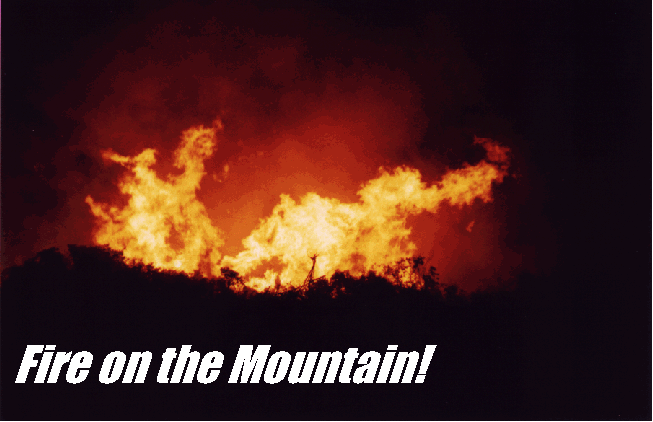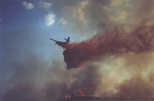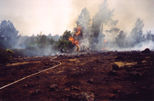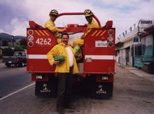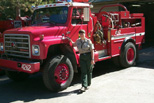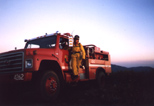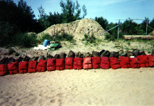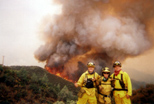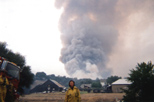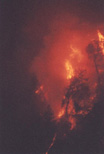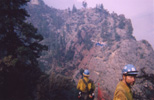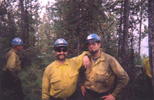|
Fire Photos & Information |
||||||||
|
||||||||
|
Northern California, August, 1999: Lightening strikes bring a cluster of fires to the hills and mountains of California. With fires in a half dozen northern California counties, as well as Riverside east of Los Angeles, United States Forest Service (USFS) and California Department of Forestry (CDF) firefighters are spread thin, battling blazes in steep, dry hills, covered with highly flammable brush and trees. CDF firefighter Jennifer Neely photographed the action in Butte County, spending 14 consecutive days on duty with hundreds of others. Husband Rod, with the USFS Sierra Hotshots, put in several 21-day work periods, first on the Pilot Fire in Stanislaus National Forest, north of Yosemite; then in the Plumas Forest farther north. His summer consisted of almost non-stop duty, including fires in Big Sur and northern California fires, as well as Alaska and Nevada. |
||||||||
Click photo for a larger view (photos open in a new window) |
||||||||
|
Flames Threaten State from North to South Fires raged out of control from late August into October 1999 in the dry hills and mountains of California. From mid-September into October, two major fires in the Big Sur area southeast of Monterey offered the challenge of dry brush and grass along with nearly inaccessible territory. Most fire fighting access was by helicopter or parachute; in late September, mule trains were utilized to bring in food and supplies. Crews from the United States Forest Service (USFS) and California Department of Fire and Forestry (CDF) were kept busy throughout the state as well as in southern Oregon. USFS Hotshot crew member Rod Neely, this webmaster’s son-in-law, spent three weeks on northern California fires in August and September. He enjoyed the two mandatory days off, but on Sunday, September 12, received a call telling him not to bother to come in at 8 a.m. the next day; instead the wanted him at 4 a.m. for departure to Big Sur. The fires threatened two monasteries hidden in the usually quiet and isolated coastal hills. Benedictine monks were evacuated from the New Camalodoli Hermitage, located at the 1300 foot elevation level at the end of a narrow, winding road. A group of eight monks remained to help firefighters protect the buildings from fire. At the Zen Buddhist Tassajara Hot Springs monastery, monks and visitors were on alert to leave at a moment’s notice if necessary. By October 3, both were 50% contained, as cooler weather and calmer winds eased the danger and difficulty. Ultimately the Hare Fire burned over 48,000 acres, and at least 35,000 acres were consumed by the Tassajera Fire. The stubborn Tehama County fire in the northern part of the state grew to 46,000 acres, with 35% containment. The lightening-caused fire burned from late August until rains quelled it in October and November. In another low-tech firefighting method, crews in helicopters tossed flaming ping pong balls in an attempt to widen a burned out strip as a fire break. California’s most destructive fire of the 1999 season exploded into a 25,000 acre inferno in a single day, driven by hot, dry winds. Before partial containment, it destroyed about 100 houses in rural Shasta County, near Redding CA. The fire is believed to have started at a campground near Lake Shasta. Before it was contained, over a thousand firefighters were working to control the blaze. State officials said a total of about 660,000 acres burned in California that year. |
||||||||
|
||||||||
|
|
||||||||
|
Crews stationed at the California Department of Forestry and Fire Protection (CDF) station at Usona in rural Mariposa County missed out on their days off for a two week period. However, they spent most of the time performing maintenance and other duties at the station. One small arson fire kept them busy overnight; while a house fire resulted in an injury to firefighter Jennifer Neely. She was struck in the mouth by a brass hose coupling, and required stitches inside and outside her mouth. She took the rest of the day off and was back to work again on Monday. The Usona crew was laid off in early November (1999), following a heavy rainfall in the mountains. |
||||||||
|
Fire
Management
Nearly everyone enjoys starting fires. Perhaps this dates from
primitive days, when keeping the fire going was often a matter of life and
death. Fortunately, most of us learn to channel this desire into setting
fires in the fireplace, campfire ring, or back yard barbecue. Firefighters get to set fires with big torches and by tossing flaming
ping pong balls out of airplanes. Most wild land fire agencies carry out
"prescribed burns" at some point during the fire season. The
purpose is to prevent a big, dangerous fire by burning off excess brush
and dead wood in a controlled manner. A slow, low, cool fire is far easier
to control than a fast-moving one with lots of fuel. Forests with lots of
dead trees and brush permit a big, fast-moving fire to get up into the
larger trees. There are stringent rules for when it’s appropriate to set fire. In
northern California in 1999, Bureau of Land Management (BLM) officials
ignored their own rules and lost control of a fire which subsequently
burned over a dozen homes. Someone is still on the "hot seat"
over that faux pas. Backfiring is another deliberate form of fire starting, and is used in
fighting wild fires. The purpose is to widen an existing fire break, burn
off fuel in a controlled way before the fire burns it in an out of control
way; and to stop a fire from burning into populated areas. |
||||||||
|
Summer of 2000 saw some of the most destructive fires in U.S. history in the western states. United States Forest Service (USFS) and California Department of Forestry (CDF) firefighters traveled throughout the west, fighting blazes that sometimes reached 200,000 acres. CDF firefighter Jennifer Neely saw action on the Concow Fire in Butte County, and the Hunter Fire in the rugged Merced River canyon in Mariposa County. Husband Rod, with the USFS Sierra Hotshots, put in 21-day work periods in Idaho and Montana, as well as shorter assignments on fires in California and Nevada. In Idaho he joined crews from throughout the country including military units on the Clear Creek fire, which grew to over 200,000 acres. It was contained only when rain and snow began to fall in September. Crews were called from New Zealand and Canada as well as the United States to fight the many blazes in Montana. Rod saw action on the Nine Mile Complex and the Alder Creek fires. In mid-October, Rod and the Sierra Hotshots returned to Montana on a rehabilitation project, building water bars and working on other erosion control efforts. |
||||||||
